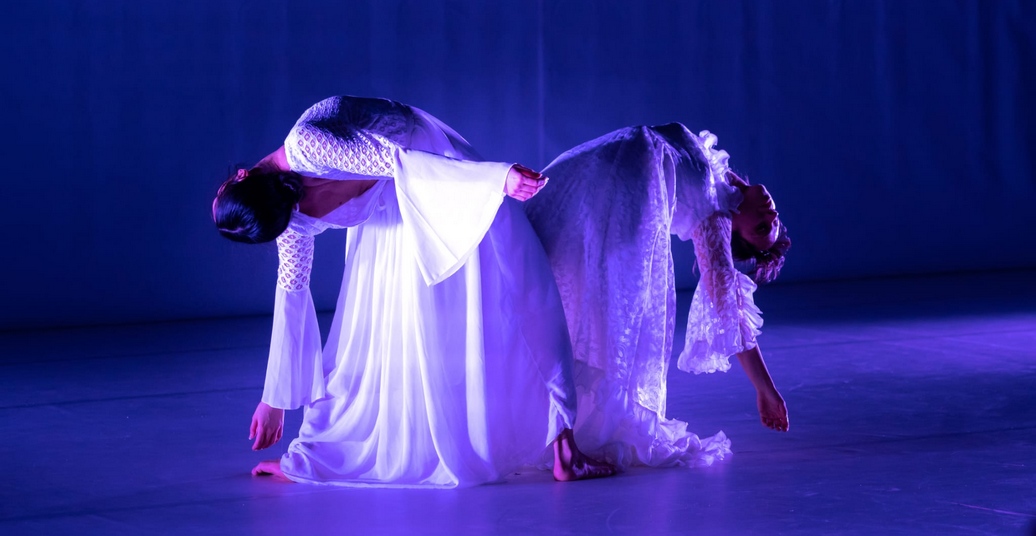Against the Grain is a night of short dance works that champions diversity and, as organiser Manuel Meza states in the introduction to the evening, aims to “open doors” for those otherwise excluded from dance because of gender, race, ableism, body characteristics or other exclusionary factor, presented on 20 May 2023 at Theaterforum Kreuzberg.
The program starts with performer/creator Andrea Valenti’s Bodies in Resistence, directed by Felipe Fizkal. The delicacy and fragility of the opening is transferred into lines across the corners of the stage, and a heavy, weighted-down, almost trudging movement. The artists state that the work addresses migration and the resistance of the body against displacement and political violences – the evolution from non-body, perhaps denied or concealed, into something expressing itself against an unseen force.
Traces of an Offspring begins with two dancers, Veronica Lillo and Sylvia Remogio, standing centre-stage and clothed completely in white (costumes: Minne Koopmans), a classical piano soundtrack offering the backdrop to a kind of tragic scenario, illustrated by the pair mirroring each other in a repeating series of almost sarcastic, dramatic gestures. As the light changes to red and the soundtrack distorts, the piece transfers into an exploration of intimacy and then grief, and the dancers join together literally through becoming enveloped in each other’s costumes, ultimately proposing a kind of strength in solidarity and connection.
The third piece of six, En Dewhore, offers a deeply unambiguous, yet comic, rebellion against the oppressions inherent to the form of ballet. Beginning with an energised tumble out from the side of the stage, performer Rebecca Kenny’s jokingly other-worldly creation prowls around a green-lit stage in a costume covered in fake breasts. Addressing the audience directly, Kenny states “I am indeed human. With all my breasts!” Kenny proceeds to feed back a series of violent tropes laid out against the body by ballet technique and norms – all of which find a receptive audience among Theaterforum Kreuzberg. There is an extreme anger inside the piece that transfers through audience participation into a celebratory hip hop ending.
ﺯﻮﻤﺗ tammūz sees performer Queen of Virginity evolve out of a cocoon-like state, hidden initially underneath a giant pink duvet cover, into a more earthly form. As the performance emerges and the soundscape transforms from atmospheric rumbles into rhythmic blasts, Queen of Virginity begins to address the audience with a science-fiction, possibly factual scenario: a first-person witness account of military activity (“drones flying low”, “a battleship”). The performance ends with a reflection on memory as a “recurring dream”, offering an abject, futuristic vision of sickness and concealment.
No such virtue offers among the freshest but most challenging performances of the evening, as the two performers Kristen Rulifson and Mei Bao explore the dynamics of intimacy and impact. Through synchronised patterns that follow the music in a uniform way, a division between the dancers slowly emerges, and expresses itself in pushes, punches, and other forms of aggression, mixed together with gestures of tenderness and closeness (such as stroking, or brushing of hair). Tom Odell’s Another Love paves the way for a finale that references choking, centre-stage. It’s a beautiful, tender work, where the artists have explored psychologically-difficult territory, and emerge on the other side with a triumphant resilience, and unique choreographic language.
The evening ends with Origins -the skin between us- (excerpt), an exploration of the divisions of race that blends first-person voiceover accounts with choreographic expression choreographed by Selina Shida Hack, drifting between solos and trios from all three dancers – Gio Cruz, Nana, and Yurika S. Yamamoto. The piece has a surface blandness that sometimes comes with documentary work, and belies some of its more delicate touches, dancers picking up the rhythms of speech of the voiceovers, and forming constellations that somehow create small interventions and a soft, glissando end to the evening.
The evening is targeted at representation of the underrepresented in dance, and the supportive buzz from the audience following the performance indicates some gathering of collective energy for pushing further into the more conservative echelons of dance institutions.




